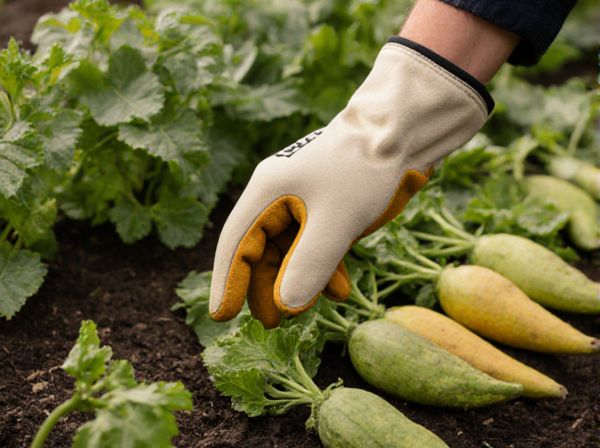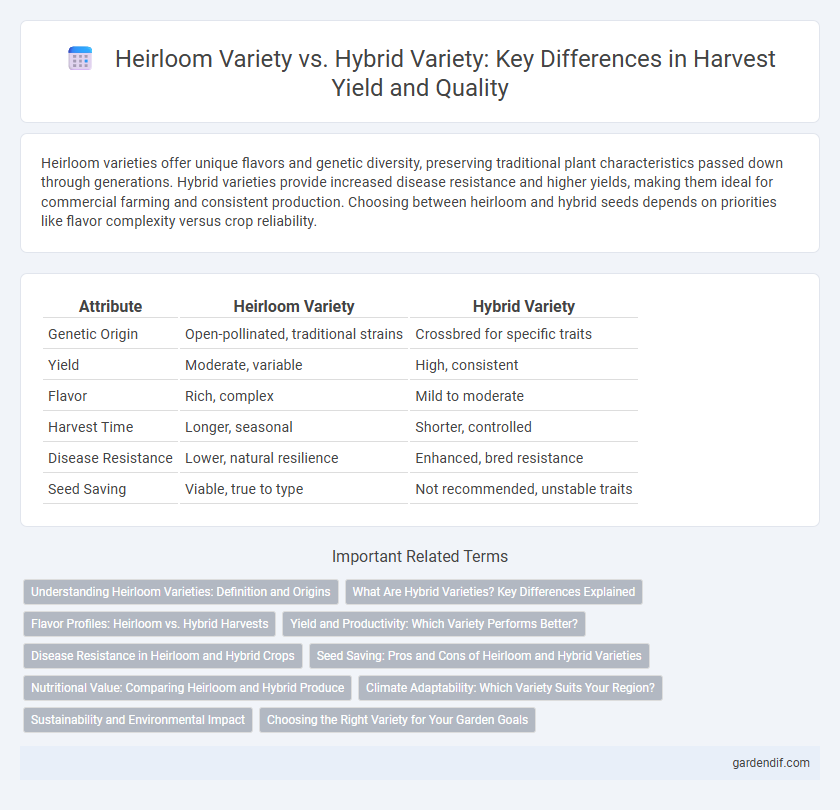
Heirloom variety vs hybrid variety Illustration
Heirloom varieties offer unique flavors and genetic diversity, preserving traditional plant characteristics passed down through generations. Hybrid varieties provide increased disease resistance and higher yields, making them ideal for commercial farming and consistent production. Choosing between heirloom and hybrid seeds depends on priorities like flavor complexity versus crop reliability.
Table of Comparison
| Attribute | Heirloom Variety | Hybrid Variety |
|---|---|---|
| Genetic Origin | Open-pollinated, traditional strains | Crossbred for specific traits |
| Yield | Moderate, variable | High, consistent |
| Flavor | Rich, complex | Mild to moderate |
| Harvest Time | Longer, seasonal | Shorter, controlled |
| Disease Resistance | Lower, natural resilience | Enhanced, bred resistance |
| Seed Saving | Viable, true to type | Not recommended, unstable traits |
Understanding Heirloom Varieties: Definition and Origins
Heirloom varieties are traditional plant cultivars passed down through generations, prized for their genetic diversity and unique flavors. Originating before the widespread use of commercial hybrid seeds, these varieties are open-pollinated, allowing gardeners to save seeds and maintain true-to-type plants. Their resilience and adaptation to local environments make heirloom varieties a valuable resource for sustainable agriculture and biodiversity conservation.
What Are Hybrid Varieties? Key Differences Explained
Hybrid varieties are plants produced by cross-breeding two different parent strains to combine desirable traits such as higher yield, disease resistance, and uniform growth. Unlike heirloom varieties, which are open-pollinated and stable over generations, hybrids often do not produce true-to-type seeds, requiring new seeds from the original hybrid cross each planting season. These characteristics make hybrids ideal for large-scale agriculture where consistency and productivity are prioritized.
Flavor Profiles: Heirloom vs. Hybrid Harvests
Heirloom varieties are prized for their complex, rich flavor profiles that reflect traditional cultivation methods and unique genetic traits, often delivering sweet, tangy, or robust tastes. Hybrid varieties, bred for consistency and disease resistance, tend to have milder, more uniform flavors that prioritize durability and shelf life over depth of taste. The choice between heirloom and hybrid harvests significantly impacts culinary experiences, with heirlooms offering more diverse, intense flavors while hybrids ensure reliable production and longer freshness.
Yield and Productivity: Which Variety Performs Better?
Heirloom varieties tend to produce lower yields compared to hybrid varieties, which are bred specifically for higher productivity and disease resistance. Hybrid varieties often outperform heirlooms in terms of overall harvest volume and growth rate, making them more suitable for commercial farming. However, heirlooms can offer unique flavors and genetic diversity that hybrids may lack.
Disease Resistance in Heirloom and Hybrid Crops
Heirloom varieties often exhibit lower disease resistance compared to hybrid crops, as they have been cultivated for flavor and heritage traits rather than resilience. Hybrid varieties are bred specifically for enhanced disease resistance through genetic diversity and controlled crossbreeding, which improves their ability to withstand pests and pathogens. This increased resistance in hybrids often leads to higher yields and reduced reliance on chemical treatments during harvest.
Seed Saving: Pros and Cons of Heirloom and Hybrid Varieties
Heirloom varieties offer the advantage of reliable seed saving, as seeds retain true-to-type traits passed down genetically, ensuring consistent harvest quality year after year. Hybrid varieties, while often yielding higher productivity and disease resistance, generally produce seeds that do not reliably reproduce the parent plant's characteristics, leading to variable or inferior crops if saved. Seed saving from heirloom varieties supports biodiversity and sustainability, whereas relying on hybrids may require purchasing new seeds annually, increasing costs and dependency on commercial suppliers.
Nutritional Value: Comparing Heirloom and Hybrid Produce
Heirloom varieties often contain higher levels of vitamins, antioxidants, and trace minerals due to their diverse genetic heritage and slower growth cycles. Hybrid varieties, bred for uniformity and yield, may sometimes sacrifice nutritional complexity despite offering improved disease resistance and shelf life. Studies indicate that heirlooms can provide a richer nutrient profile, particularly in antioxidants like lycopene and beta-carotene, essential for health benefits.
Climate Adaptability: Which Variety Suits Your Region?
Heirloom varieties exhibit strong adaptability to local climate conditions due to their long-term cultivation in specific regions, making them ideal for farmers seeking resilience in traditional weather patterns. Hybrid varieties are bred for enhanced climate tolerance, including resistance to drought, heat, and varying soil conditions, offering higher yields in more unpredictable environments. Selecting between heirloom and hybrid varieties depends on regional climate stability and the farmer's goal for either genetic preservation or optimized productivity.
Sustainability and Environmental Impact
Heirloom varieties promote biodiversity by preserving genetic diversity, which enhances ecosystem resilience and reduces dependency on chemical inputs. Hybrid varieties often require increased pesticide and fertilizer use, contributing to environmental degradation and soil depletion. Cultivating heirloom crops supports sustainable agriculture practices by maintaining natural pest resistance and adapting to local environmental conditions.
Choosing the Right Variety for Your Garden Goals
Heirloom varieties offer rich flavors and preserved genetic diversity, ideal for gardeners seeking authentic taste and traditional plant traits. Hybrid varieties provide higher yields, disease resistance, and uniform growth, making them suitable for maximizing productivity and managing garden health. Selecting the right variety depends on prioritizing either unique characteristics and seed saving or increased harvest efficiency and crop resilience.
Heirloom variety vs hybrid variety Infographic

 gardendif.com
gardendif.com